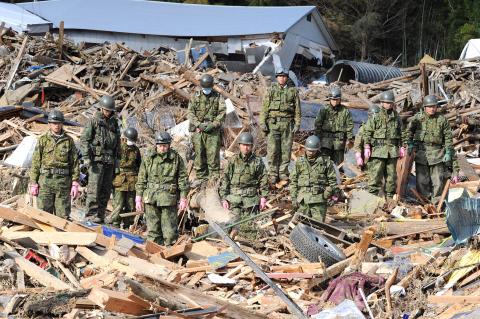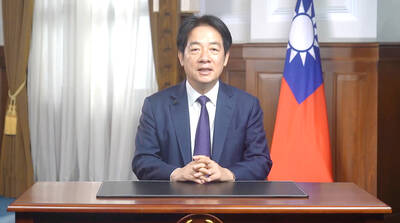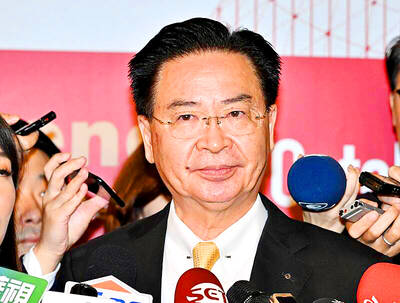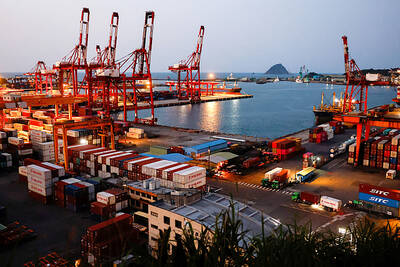Japanese engineers said yesterday that burying a crippled nuclear plant in sand and concrete may be a last resort to prevent a catastrophic radiation release. The same method was used to seal huge leakages from Chernobyl in 1986.
However, they still hoped to solve the crisis by fixing a power cable to two reactors by today to restart water pumps needed to cool overheating nuclear fuel rods. Workers also sprayed water on the No. 3 reactor, the most critical of the plant’s six reactors.
It was the first time the facility operator had acknowledged burying the sprawling complex was possible, a sign that piecemeal actions such as dumping water from military helicopters or scrambling to restart cooling pumps may not work.

Photo: AFP
“It is not impossible to encase the reactors in concrete, but our priority right now is to try and cool them down first,” an official from the plant operator, Tokyo Electric Power Co, told a news conference.
As Japan entered its second week after a magnitude 9.0 earthquake and 10m tsunami flattened coastal cities and killed thousands of people, the world’s worst nuclear crisis since Chernobyl looked far from over.
The nuclear disaster has triggered global alarm and reviews of safety at atomic power plants around the world.
“This is something that will take some time to work through, possibly weeks, as you eventually remove the majority of the heat from the reactors and then the spent-fuel pools,” US Nuclear Regulatory Commission chairman Gregory Jaczko told a news conference at the White House.
Millions of people in Tokyo continued to work from home, some fearing a blast of radioactive material from the complex 240km to the north, although the International Atomic Energy Agency said radiation levels in the capital were not harmful.
That is little solace for about 300 nuclear plant workers toiling in the radioactive wreckage. They are wearing masks, goggles and protective suits, the seams of which are sealed off with duct tape to prevent radioactive particles from creeping in.
“My eyes well with tears at the thought of the work they are doing,” Kazuya Aoki, a safety official at Japan’s Nuclear and Industrial Safety Agency said.
Even if engineers restore power at the plant, the pumps may be too damaged from the earthquake, tsunami or subsequent explosions to work. The first step is to restore electricity to pumps for reactors No. 1 and No. 2 by today.
By tomorrow, the government expects cooling pumps for badly damaged reactors No. 3 and No. 4 to have power, Japan’s nuclear agency spokesman Hidehiko Nishiyama said.
Asked about burying the reactors in sand and concrete, he said: “That solution is in the back of our minds, but we are focused on cooling the reactors down.”
Some experts said dumping water from helicopters to try to cool spent-fuel pools would have little impact.
“One can put out forest fires like this — by pouring water from far above, said Russian nuclear expert Gennady Pshakin. “It is not clear where this water is falling. There is no control.”
Japan raised the incident level at the crippled plant to five on a scale called INES to rank nuclear accidents, up from four, on a one to seven scale.
That puts it on a par with the Three Mile Island accident in the US in 1979, although some experts say it is more serious. Chernobyl was a seven on the INES scale.
The plight of hundreds of thousands left homeless by the earthquake and tsunami worsened following a cold snap that brought heavy snow to worst-affected areas.
Supplies of water, heating oil and fuel are low at evacuation centers, where many survivors wait bundled in blankets. Many elderly lack proper medical supplies. Food is often rationed.
The government said yesterday it was considering moving some of the hundreds of thousands of evacuees to parts of the country unscathed by the devastation.
Nearly 320,000 households in the north were still without electricity in near-freezing weather yesterday afternoon, Tohuku Electric Power Co said, and the government said at least 1.6 million households lacked running water.
The National Police Agency said yesterday it had confirmed 6,539 deaths from the quake and tsunami, exceeding the 6,434 who died after the Kobe earthquake in 1995, but 10,354 people are still missing.
The government has told everyone living within 20km of the plant to evacuate and advised people within 30km to stay indoors.
The US embassy in Tokyo has urged citizens living within 80km of the Fukushima Dai-ichi plant to evacuate or remain indoors “as a precaution,” while Britain’s foreign office urged citizens “to consider leaving the area.”

US President Donald Trump yesterday announced sweeping "reciprocal tariffs" on US trading partners, including a 32 percent tax on goods from Taiwan that is set to take effect on Wednesday. At a Rose Garden event, Trump declared a 10 percent baseline tax on imports from all countries, with the White House saying it would take effect on Saturday. Countries with larger trade surpluses with the US would face higher duties beginning on Wednesday, including Taiwan (32 percent), China (34 percent), Japan (24 percent), South Korea (25 percent), Vietnam (46 percent) and Thailand (36 percent). Canada and Mexico, the two largest US trading

ACTION PLAN: Taiwan would expand procurement from the US and encourage more companies to invest in the US to deepen bilateral cooperation, Lai said The government would not impose reciprocal tariffs in retaliation against US levies, President William Lai (賴清德) said yesterday, as he announced five strategies to address the issue, including pledging to increase Taiwanese companies’ investments in the US. Lai has in the past few days met with administrative and national security officials, as well as representatives from various industries, to explore countermeasures after US President Donald Trump on Wednesday last week announced a 32 percent duty on Taiwanese imports. In a video released yesterday evening, Lai said that Taiwan would not retaliate against the US with higher tariffs and Taiwanese companies’ commitments to

‘SPECIAL CHANNEL’: Taipei’s most important tasks are to stabilize industries affected by Trump’s trade tariffs and keep negotiations with Washington open, a source said National Security Council Secretary-General Joseph Wu (吳釗燮) arrived in the US for talks with US President Donald Trump’s administration, a source familiar with the matter said on Friday. Wu was leading a delegation for a meeting known as the “special channel,” the Financial Times reported earlier. It marked Trump’s first use of the channel since returning to the White House on Jan. 20. Citing a source familiar with the matter, the Financial Times reported that Minister of Foreign Affairs Lin Chia-lung (林佳龍) was also a part of the delegation. The visit came days after China concluded war games around Taiwan and amid Trump’s

CHIP EXCEPTION: An official said that an exception for Taiwanese semiconductors would have a limited effect, as most are packaged in third nations before being sold The Executive Yuan yesterday decried US President Donald Trump’s 32 percent tariff on Taiwanese goods announced hours earlier as “unfair,” saying it would lodge a representation with Washington. The Cabinet in a statement described the pledged US tariffs, expected to take effect on Wednesday next week, as “deeply unreasonable” and “highly regrettable.” Cabinet spokeswoman Michelle Lee (李慧芝) said that the government would “lodge a solemn representation” with the US Trade Representative and continue negotiating with Washington to “ensure the interests of our nation and industries.” Trump at a news conference in Washington on Wednesday announced a 10 percent baseline tariff on most goods